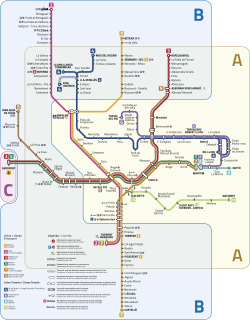
Back Метрапалітэн Валенсіі (Іспанія) Byelorussian ভালেনসিয়া মেট্রো Bengali/Bangla Metrovalència Catalan Metro Valencia German Metroo de Valencio Esperanto Metrovalencia Spanish Valentziako metroa Basque Valencian metro Finnish Métro de Valence French MetroValencia Galician
| Metrovalencia | |||
|---|---|---|---|
 | |||
| Overview | |||
| Owner | FGV | ||
| Locale | Valencia, Spain | ||
| Transit type | Rapid transit, tram | ||
| Number of lines | 10[1]
| ||
| Number of stations | 146
| ||
| Daily ridership | 190,253 (avg. weekday, 2019) | ||
| Annual ridership | 69,442,539[2] (2019) | ||
| Chief executive | Anaís Menguzzato | ||
| Operation | |||
| Began operation | 8 October 1988 (as FGV) 21 May 1994 (as Valencia Tram) 5 May 1995 (as MetroValencia) | ||
| Number of vehicles | 106[1] | ||
| Technical | |||
| System length | 161.7 km (100.5 mi)[1]
| ||
| Track gauge | 1,000 mm (3 ft 3+3⁄8 in) metre gauge | ||
| Electrification | 750 V DC 1500 V DC, overhead wire | ||
| |||
Metrovalencia[a] is an urban rail including rapid transit and trams, serving Valencia and its metropolitan area. The network is a modern amalgamation of former FEVE narrow gauge electric-operated suburban railways. It is a large suburban network that crosses the city of Valencia, with all trains continuing out to the suburbs. It also has destinations on lines that make it more closely resemble commuter trains. The unique system combines light railway, metro and several tram operations north of the Túria riverbed park with line 4. Trains of lines 1, 3, 5 and 9 have automatic train operation (ATO) in 25.3 kilometers of underground system.[3] Tram lines 4, 6, 8 and 10 are operated by modern trams.[4]
This network consists of more than 161.7 km of route, of which 29.8 km is underground.[1]
The system authority Ferrocarrils de la Generalitat Valenciana (FGV) uses bilingual signage in Valencian and Spanish.
- ^ a b c d "FGV en cifras > Metrovalencia en cifras > Datos de la red de Metrovalencia" [FGV figures > Metrovalencia figures > Data on the Metrovalencia network] (in Spanish). FGV. 2014.
- ^ "Metrovalencia alcanza los 69,4 millones de viajeros en 2019, la cifra "más alta de su historia"". La Vanguardia (in Spanish). 18 January 2020. Retrieved 3 April 2020.
- ^ "El metro de Valencia pone en marcha el sistema de conducción automático" (in Spanish). 26 March 2011. Retrieved 14 May 2014.
- ^ "Conversion Of Railway Lines For Suburban Passenger Services" (PDF). The World Bank. Retrieved 7 May 2011.
Cite error: There are <ref group=lower-alpha> tags or {{efn}} templates on this page, but the references will not show without a {{reflist|group=lower-alpha}} template or {{notelist}} template (see the help page).
